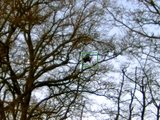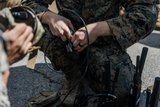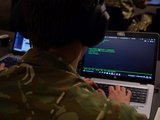USAF orders extra SABR AESA radars for F-16s
Northrop Grumman is to produce 31 more AN/APG-83 Scalable Agile Beam Radar (SABR) AESA radars for USAF F-16 fighter aircraft under an $88.24 million contract modification from the Air Force Life Cycle Management Center.
Work is expected to be completed by late July 2025, the DoD announced on 22 July.
The modification brings the total cumulative face value of the SABR contract for Northrop Grumman to almost $1.22 billion.
The original seven-year deal was awarded in May 2017.
AN/APG-83 is a programme of record for active-duty and reserve USAF units as well as the Air National Guard (ANG). The system features all-weather, high-resolution synthetic aperture radar mapping, to present the pilot with a large surface image for more precise target identification and strike compared to legacy systems.
As well as SABR, Northrop Grumman is also equipping USAF Reserve and ANG F-16s with the AN/ASQ-236 Dragon’s Eye AESA pod.
According to Shephard Defence Insight, the AN/ASQ-236 synthetic aperture radar pod can be used to assist cartography, generate bomb damage assessments and perform general day and night surveillance.
Related Equipment in Defence Insight
More from Digital Battlespace
-
![EID to unveil new vehicle communication system at DSEI]()
EID to unveil new vehicle communication system at DSEI
The Portuguese company’s naval communications system is in service across more than a dozen countries. It has turned to its home nation for support in developing a new vehicle based C2 system.
-
![Chess Dynamics successfully demonstrates Vision4ce AI-driven tracker]()
Chess Dynamics successfully demonstrates Vision4ce AI-driven tracker
The Vision4ce Deep Embedded Feature Tracking (DEFT) technology software is designed to process video and images by blending traditional computer vision with artificial intelligence (AI) algorithms to present actionable information from complex environments.
-
![Wave Relay devices cleared for security use on commercial systems in industry trend]()
Wave Relay devices cleared for security use on commercial systems in industry trend
Persistent Systems has been cleared by National Security Agency (NSA) to transmit sensitive data on commercial networks. The devices are added to the NSA’s Commercial Solutions for Classified (CSfC) component list which also includes other companies’ products providing the same security.
-
![UK teases cyber spending boost in Strategic Defence Review ahead of “imminent” release]()
UK teases cyber spending boost in Strategic Defence Review ahead of “imminent” release
The release of the UK’s Strategic Defence Review (SDR) has been long promised as mid-year. It is possible it could be as early as 2 June although the UK Ministry of Defence (MoD) continues to play its cards close to its chest.
-
![Intelsat emphasises SATCOM resilience for SOF in contested domains (video)]()
Intelsat emphasises SATCOM resilience for SOF in contested domains (video)
Intelsat outlines how its multi-orbit SATCOM architecture is enhancing connectivity and resilience for special operations forces operating in degraded and contested environments.
-
![US Space Force’s next-generation missile warning system moves forward with $500 million in new contracts]()
US Space Force’s next-generation missile warning system moves forward with $500 million in new contracts
Next-Generation Overhead Persistent Infrared (Next-Gen OPIR) satellites are intended to provide early warning of missile launches from any location worldwide and new ground stations will result in expanded coverage of critical missile warning.























